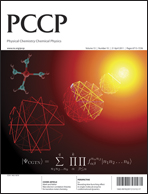Vibrational relaxation and dephasing of Rb2 attached to helium nanodroplets†
Abstract
The vibrational wave-packet dynamics of diatomic rubidium molecules (Rb2) in triplet states formed on the surface of superfluid helium nanodroplets is investigated both experimentally and theoretically. Detailed comparison of experimental femtosecond pump–probe


 Please wait while we load your content...
Please wait while we load your content...